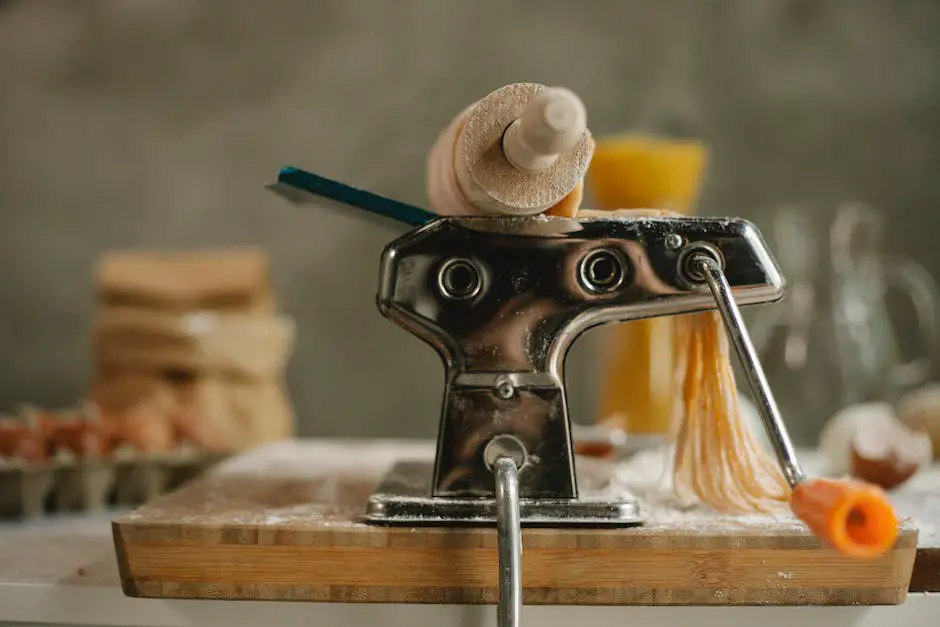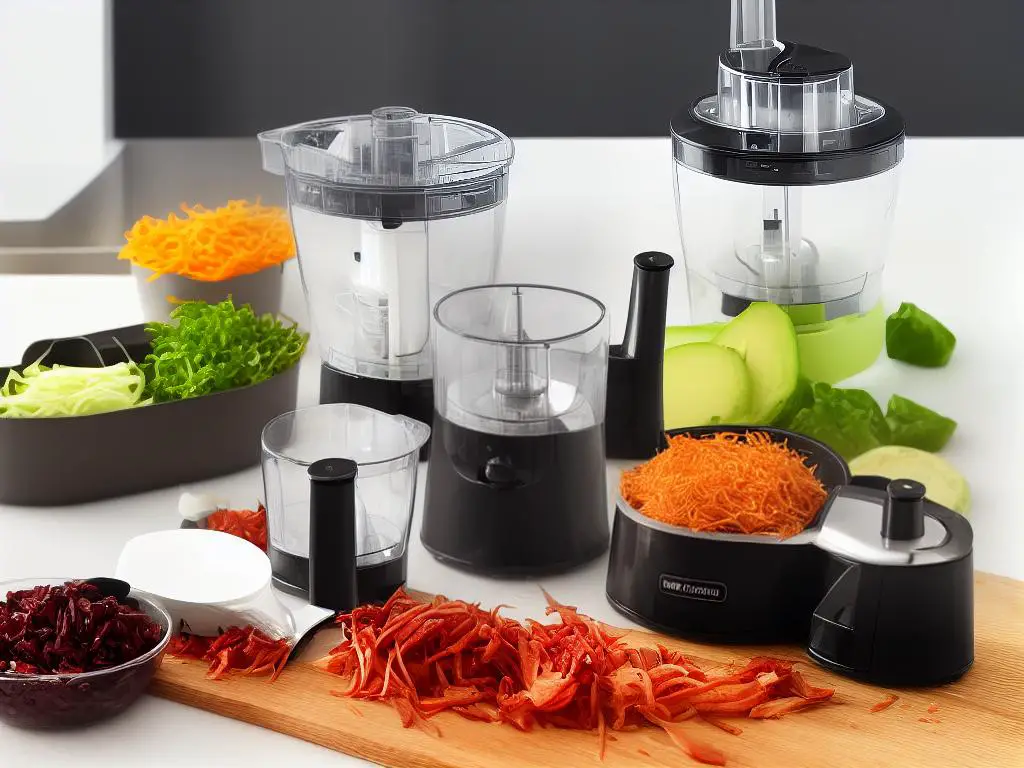Master Your Food Processor Attachments: A Guide
Food processors have revolutionized our approach to meal preparation, making it quicker and more efficient than ever before. These versatile kitchen appliances are designed to perform numerous food prep tasks using various attachments and accessories, freeing up time and simplifying the cooking process. In this comprehensive guide, we will explore the world of food processor attachments, providing insights into their functionalities, applications, maintenance, and even recipes, to help you get the most out of your appliance and elevate your culinary skills.
Understanding the Basics
A food processor is a versatile kitchen appliance that simplifies and speeds up food preparation tasks such as chopping, shredding, slicing, mixing, and puréeing. A food processor is made up of attachments that allow it to complete different functions. These attachments include cutting discs, s-shaped blades, shredding and grating discs and fit onto the motorized base of the unit.
When shopping for a food processor, several factors should be considered, including specific requirements such as frequency of use, the type of recipes to prepare, and available storage space in one’s kitchen. While a standard food processor has only one motor speed, some high-end models have adjustable speeds, pulse options, and other advanced features for greater control and precision.
Owning a food processor with multiple attachments is beneficial since it eliminates the need for several kitchen appliances. For instance, a slicing attachment can replace a mandoline slicer, while a grating attachment eliminates the need for a standalone grater. Food processors are versatile appliances and can successfully perform various food preparation tasks, including slicing, shredding, grinding, and mixing.

Blades and Discs
Proper use and maintenance of food processor attachments are critical to extend the longevity and performance of the appliance. It is crucial to read the manufacturer’s instruction regarding disassembly, assembly, and cleaning of the attachments as mishandling or improper use can cause damage or reduce the appliance’s durability.
Food processors have gained immense popularity in household kitchens, courtesy of their versatility in carrying out various tasks. These kitchen wonders are equipped with an array of interchangeable blades and discs that make food preparation easier and more efficient. Understanding the different attachments and their purposes is essential in making the most of your food processor and navigating your way through a myriad of preparation tasks.
Accessories and attachments can enhance the food processor’s capabilities and provide an elevated culinary experience regardless of one’s skill level. Available attachments that can turn a standard food processor into a functional appliance include juice extractors, meat grinders, and ice cream makers. By understanding the basics of a food processor, its uses, and various types, individuals can make an informed decision when purchasing one to fulfill their unique needs and preferences.
Slicing discs are perhaps one of the most commonly used attachments. They come in various sizes and thicknesses, giving you control over the precise cut of your ingredients. Slicing discs are perfect for slicing fruits, vegetables, and even meats with ease, making tasks like preparing homemade potato chips or slicing cucumbers a breeze. Finer, thinner slicing options can also aid in preparing elegant dishes that require meticulous slicing, such as vegetable terrines or ratatouille. Chopping or mixing blades, also known as the ‘S’ blade, are designed for multiple purposes and are a staple among food processor attachments. Perfect for mincing, pureeing, and grinding various ingredients, this attachment is indispensable in preparing ingredients for dishes like salsa, pesto, or hummus. Furthermore, the ‘S’ blade can be highly effective in handling heavier doughs, such as making pie crusts or kneading bread dough, which can save you significant time and effort in your baking endeavors.Grating or shredding discs are another handy attachment for your food processor, helping you shred vegetables, fruits, and cheeses with ease. Fine grating options are excellent for ingredients like hard cheeses, chocolates, or citrus zest, while a coarse grating option is more suitable for vegetables like carrots and cabbage. Such functionality allows preparing dishes like coleslaw, hash browns, or pizza toppings to be simple and efficient. Julienne or matchstick blades offer an additional creative option for food processors, allowing users to create uniform, thin strips of vegetables, fruits, or cheeses. These blades assist in preparing dishes such as stir-fries, salads, or garnishes, enhancing the visual appeal of your culinary creations. As with all food processor attachments, understanding the capabilities of each blade can unlock a world of possibilities, helping you save time, effort, and elevate your cooking skills to new heights.

Dough and Mixer Attachments
Further expanding the versatility of a food processor are attachments like dough and mixer attachments, which enable users to knead dough, mix batters, and combine ingredients with ease. These attachments are specifically designed to provide optimal processing results, ensuring that ingredients are evenly mixed and dough achieves the desired consistency. By utilizing the appropriate attachments, home cooks can effortlessly attain professional-quality results right from their kitchens.
Dough Attachments
Dough attachments typically include dough hooks or dough blade, which are designed to handle heavier, more dense dough such as bread and pizza dough. These attachments work by folding and stretching the dough, mimicking the manual kneading process. The well-kneaded dough is crucial for developing gluten, the protein that provides structure, elasticity, and chewiness to bread products. With a dough attachment, the need for laborious manual kneading is reduced, saving time and effort on lengthy baking projects.
Mixer Attachments
Mixer attachments, on the other hand, primarily consist of metal or plastic paddle attachments, which are more suitable for medium-consistency batters, such as cake or pancake batters. These attachments work by thoroughly mixing wet and dry ingredients, ensuring that no lumps or dry patches remain. Additionally, mixer attachments can be used to make lighter dough, like pie crusts and cookies, to ensure that the mixture is evenly combined and the right texture is achieved.
Whisk Attachments
In addition to dough and mixer attachments, food processors may also come with whisk attachments for lighter, more aerated mixtures, such as whipped cream or meringues. By incorporating the proper amount of air into the mixtures, these attachments enable users to achieve the desired consistency and aeration necessary for specific recipes. The whisk attachment can also be beneficial for emulsifying ingredients, such as blending oil and vinegar to make a smooth salad dressing.
Considerations for Food Processor Attachments
When selecting a food processor with dough and mixer attachments, it is essential to consider the machine’s power and capacity. A powerful motor and a sizeable mixing bowl will ensure efficient and effective processing of various types of dough and batters. Additionally, be sure to choose a food processor with easily removable attachments, as this will facilitate cleaning and maintenance. By investing in a food processor with the appropriate dough and mixer attachments, home cooks can enhance their culinary experiences and enjoy the convenience and versatility that these appliances provide.

Photo by cmalquist on Unsplash
Specialty Attachments
Another useful attachment for a food processor is the juicer attachment, which allows you to transform your appliance into a versatile device capable of extracting juice from various fruits and vegetables. This attachment often features a sieve that separates the juice from the pulp, ensuring a smooth and refreshing beverage. It is especially beneficial for those who enjoy creating their own nutritious drinks, like fresh fruit juice or green smoothies, contributing to a healthy and balanced diet. Some juicers also have attachments that can process leafy greens, herbs, and even wheatgrass. Combining these valuable attachments with your food processor, you can achieve diverse culinary creations and cater to a wide range of taste preferences and dietary requirements.
Dicer attachments enable your food processor to quickly and uniformly cut fruits, vegetables, and even cheese into small, precise cubes or squares. These particular attachments often include multiple blade options, allowing you to adjust the size and shape of the pieces you wish to create. This feature is particularly useful for meal prepping, as it significantly reduces the time needed to chop ingredients for salads, soups, and other dishes. It also ensures consistent results, making your meals appear more appealing and professional.
The spiralizer attachment is a popular addition to many modern food processors, perfect for those looking to explore new and creative methods for preparing fruits and vegetables. This attachment is designed to create continuous curls or “noodles” from a variety of produce such as zucchini, carrots, apples, and cucumbers. It’s particularly popular amongst people who follow low-carb or gluten-free diets, as it provides a healthy alternative to traditional pasta and noodles. Moreover, spiralized veggies and fruits can also be used to create visually striking salads or as an inventive garnish for your dishes.
Sometimes, a food processor will offer a specific attachment for kneading dough, which can be a game-changer for passionate bakers. This attachment streamlines the process of mixing and kneading dough for bread, pizza, and pastries, without the need for manual labor or a separate stand mixer. With a dough blade, your food processor can handle various types of dough, ranging from soft and sticky to firm and elastic. This allows you to venture into various baking recipes and explore different types of bread, making your food processor a multitasking powerhouse in your kitchen.
Food processors offer a world of versatility in the kitchen, and their functionality can be greatly enhanced by using specific attachments such as grating and shredding blades. These blades are designed to deliver the perfect results when handling ingredients like cheese, vegetables, and nuts. Not only do they save time, but they also help maintain the texture and integrity of your ingredients. Many attachments also feature multiple thickness settings, allowing you to further tailor the consistency and presentation of your dishes to meet your culinary preferences.

Photo by cmalquist on Unsplash
Maintenance and Storage
Keeping your food processor attachments in great condition through regular cleaning and maintenance is essential for optimizing their performance. Before cleaning or disassembling your food processor, always unplug the device to ensure safety. Carefully remove the blade attachments, being cautious to avoid injury. Proceed to clean the blades and other attachments with warm soapy water, or if they are dishwasher-safe, place them on the top rack of your dishwasher. Be sure to consult the manufacturer’s guidelines for the most effective cleaning methods. To prevent rust and wear, it is crucial to dry the attachments completely after cleaning.
Proper storage of food processor attachments is crucial for preserving their quality and extending their lifespan. Designate a specific place in your kitchen cabinets or drawers to store the attachments when they are not in use. Storing the blades in protective blade covers or sheaths can also prevent them from becoming dull or damaged. It is essential to keep the food processor attachments away from moisture, as this can cause rust and reduce the functionality of your appliance.Over time, food residue and buildup may accumulate in hard-to-reach areas of the attachments. Inspect the attachments regularly for any signs of buildup and clean them as necessary. In some cases, a small brush, toothpick, or cotton swab can be helpful in reaching and cleaning these areas. Regularly inspecting your attachments for damage or wear can also help maintain their performance; look for any bent, warped, or chipped parts and replace them as needed.A well-maintained food processor will give you more efficient and precise results. Lubricating the motor of your processor – by applying a small amount of food-grade lubricant to the motor shaft – can help to reduce friction and prolong the life of the appliance. Always refer to the manufacturer’s maintenance recommendations for specific guidance. Another tip for ensuring the longevity of your food processor attachments is to be mindful of the foods you process. Overloading the machine or processing foods that are too hard, such as large nuts or ice, can put excessive strain on your attachments and cause them to wear out faster.
Proper maintenance and storage of your food processor attachments are essential for ensuring that your appliance remains in good working condition, providing optimal performance in your culinary endeavors. Regular cleaning, attentive storage, and frequent inspection will go a long way in protecting the longevity of your food processor attachments. By taking these steps, you’ll be able to make the most of your investment in this versatile and efficient kitchen appliance.

Recipes and Techniques
A food processor is a multifaceted kitchen tool capable of handling various recipes and techniques, making your time in the kitchen more efficient and enjoyable. One popular recipe to make using a food processor is homemade pesto. This tasty condiment is made by combining fresh basil, garlic, pine nuts, grated Parmesan cheese, and olive oil in the processor’s bowl and using the ‘S’ blade to chop and blend the ingredients into a smooth, flavorful sauce. Pesto can be used to dress pasta, spread on sandwiches, or mixed into salads for an extra layer of flavor, all made possible through the proper use and care of your food processor attachments.
Another great technique to utilize your food processor is making your own nut butter. The appliance’s power and durability allow you to create a variety of nut butters, from classic peanut butter to more exotic options like almond or cashew butter. To make nut butter, simply add the nuts of your choice to the processor and use the “S” blade to blend them until they reach your desired consistency. For a creamier texture, add a small amount of oil to the nuts while they’re blending, and you may need to stop the machine and scrape down the sides of the bowl between processing to ensure an even mixture.
The food processor’s slicing and shredding attachments can also bring more efficiency to your meal preparation. Instead of spending time chopping vegetables by hand, you can quickly slice them in the food processor to be used in stir-fries, casseroles, and other dishes. The shredding attachment makes shredding cheese or vegetables a breeze, turning a potentially time-consuming task into a quick and easy step. For example, you can use the shredding attachment to make homemade coleslaw by shredding cabbage and carrots before tossing them in your favorite dressing.
In addition to chopping, slicing, and shredding, a food processor can also help you make light and tender pastry dough. To make pie crust, for example, you can use the processor’s dough attachment to cut cold butter or shortening into flour, creating a flaky texture with minimal effort. After pulsing the ingredients until they resemble coarse crumbs, you’ll simply add a small amount of ice water and pulse again, just until the dough comes together. This technique can also be used to create other baked goods, such as scones, biscuits, or homemade crackers.
Finally, the food processor can be a useful tool for creating delicious and nutritious smoothies. The ability to blend fruits and vegetables quickly and efficiently, while also retaining their nutrients, sets the food processor apart from less-powerful appliances. Simply throw in your preferred combination of fruits, vegetables, and liquids, such as almond or coconut milk, and your food processor will blend them into a smooth and refreshing beverage to enjoy anytime. With so many potential applications, investing in a high-quality food processor can greatly expand your culinary repertoire, while also simplifying and streamlining your time spent in the kitchen.

Armed with the knowledge and understanding of food processor attachments, you can now confidently use your appliance to its full potential, creating delicious and impressive dishes with ease. From mastering basic operations such as slicing, chopping, and grating to experimenting with specialty attachments, the possibilities are nearly endless. As a well-informed user, you can now also ensure proper maintenance and storage of your attachments, ensuring your food processor remains in optimal working condition for years to come. We hope that this guide has provided valuable insights into the world of food processor attachments, and we wish you countless hours of enjoyable and efficient meal preparation.
